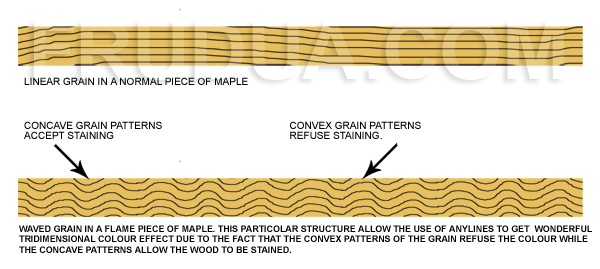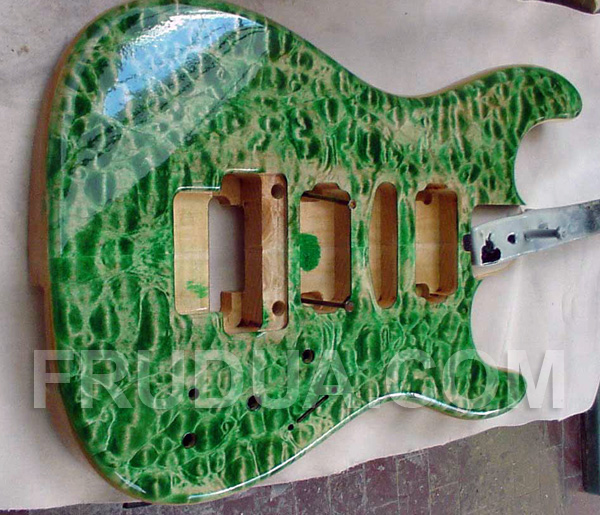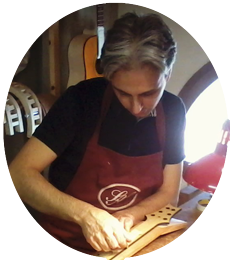
Visit the new website: www.buildyourownguitaronline.com
HOME > Guitar woods maple
GUITAR WOODS: MAPLE
Among the physical properties of wood, we are more interested with what concerns for tone we have:
1) Stiffness (elasticity coefficient along the grain). This is more important for acoustic guitars and violin top construction,
2) wood density (i.e. coefficient of propagation of sound inside wood),
3) Internal friction (attitude of a material to dampen the energy which we apply to wood here).

Maple is by far the best wood for what concerns density/stiffness ratio and is the most used wood for electric bass and guitar construction, especially necks.
Maple's performance is only surpassed by spruce, which actually is not as stiff so it can't be used in neck construction.
There are different families of maple used in guitar construction:
-
Hard rock maple and birdseye maple (Acer saccharum/Nigrum).
This is the hardest one and comes from the North American and Canadian forests.
The tree grows to a maximum hight of 40mt with 1 mt diameter. Weight is about 720kg/mt3.
Hard rock maple is mainly used for neck construction and bass top plates.
American Curly maple. Curly maple is a part of this wood family. Its figure is somewhat more "wierd" and irregular than softer European flame maple (see below)
top plates.
-
European Flame maple (Acer pseudo-platanus). This is a medium density wood coming from
east European countries and France. It is mainly used for electric guitar top
and top plates, hollow body guitars and arched instrument necks, back and sides.
The tree grows to a hight of 35 mt with a 1 mt diameter. Weight is average 600kg/mt3.
- Quilted maple (Acer macrophillus). This is an american wood featuring an amazing figure which grows in the Oregon forests. It is slightly denser and heavier than European maple and it's mainly used for top and top plates construction. The tree may reach 30 mt height and 1,2 mt diameter. Weight is about 610kg/mt3.
The beautiful figure of the curly, birdseye and quilt maple tops are the result of a genetical illness of the tree,
of which origins are still unknown. Figured maples are beautiful to see but, due to their weird grain structure and
figure they are less stable than plain maple so it's use for neck building is not recommended and there isn't any
direct relationship between the marvellous look and the tone of those woods.
The density and stiffness of maple produces a bright and articulated tone with a good attack and a very good sustain.
BODIES
The use of maple for the body is not common, even if in the past we have seen good sounding instruments made in quilted maple and European flame maple.
In case you mean to use a maple body we highly recommend softer species (European) and a deep sounding neck at
tapping.
North American species tend to be too bright. European and Oregon species tend to sound slightly brighter than alder and with some accentuated attack.
NECKS
Due to its stiffness and therefore stability, hard rock maple (Acer saccharum/Nigrum) has become the main wood for building bass and guitar necks,
bolt on or neck through since Leo Fender introduced it in
larger scale production in 1954 on the Telecaster. It is actually matched with fretboards made in maple,
Indian rosewood, ebony and less frequently in other kinds of exotic woods.
Necks made in curly, flame and birdseye maple tend to be less stable than plain maple necks.
This is due to the irregular grain pattern which is responsible for the beauty of these woods. Even more care in
seasoning is consequently recommended.

FRETBOARDS
The use of maple for fretboards produces accentuated highs and mids with good volume, enhancing tone
"liveliless" which makes your tone on a solo stand out of the groove. Maple is ideal on guitars made with neutral body woods like
mahogany or
basswood or more in general to brighten the tone and add definition.
TOPS
Maple is often used for "tops" layers of wood which may vary from a very thin 0.7mm veneer,
to 6-7mm thick drop tops, to 10-18mm thick wonderful figured tops which are glued onto the guitar body and then carved to add brightness
and a sharper attack to more neutral woods like mahogany, alder and basswoods.
COLOUR/FINISHING
The beautiful maple figure and the clear creamy colour makes maple very suitable for wonderful 3-dimensional
finishes applied with anilines.
The use of maple for fretboards requires the wood to be treated with hard finishes like urethane or acrylic to
preserve it's natural colour and protect it from sweat, moisture, dirt, etc.
Figured maple shows a typical alternate concave and convex grain pattern (see previous picture).
When staining a figured maple top or board with anilines, the convex part of the grain fiber rejects the colour while
the concave part absorbs it. Sanding the wood will return the convex part of the grain to its natural white creamy colour,
while the concave parts will still retain the aniline colour.



